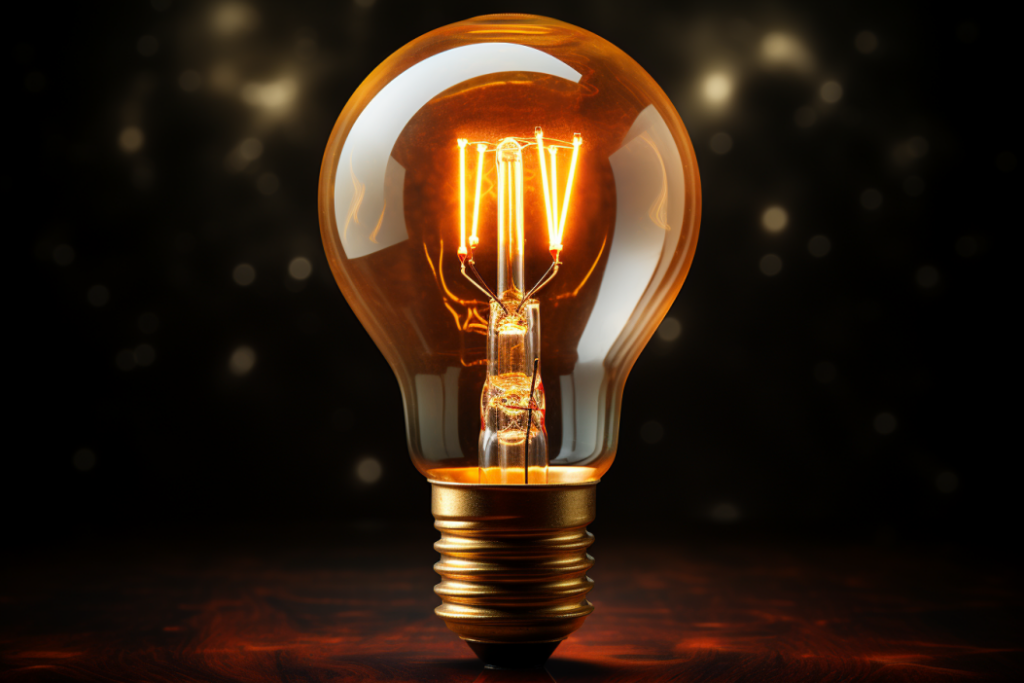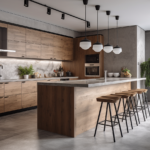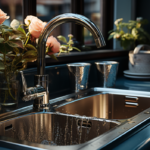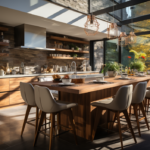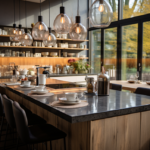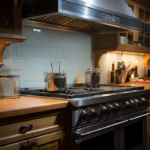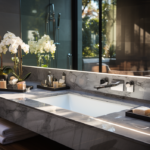Table of Contents
Maximizing Savings: Top Home Upgrades for Enhanced Energy Efficiency
Hey there, home improvement enthusiasts!
Are your utility bills making your wallet feel light? Or perhaps, you’re simply wanting to do your part for Mother Earth by reducing your carbon footprint? Look no further! It’s time to turn your eye towards home improvements that clock up some serious energy efficiency.
It sounds technical, but trust me, it’s not rocket science. It can be as simple as switching to a better kind of lightbulb or as fancy as getting solar panels all over your roof. It’s all about making clever choices that make your home not only comfortable to live in but also friendly to your budget and our planet.
From the small tweaks to the significant renovations, our guide, ‘Best Home Improvements for Better Energy Efficiency’, is ready to become your handbook for energy-smart home upgrades. We’re talking improvements that look good and save you a lot of your hard-earned cash in those fiery utility bills.
Fasten your tool belts and join us as we light the path to a greener and more efficient home, room by room. So, let’s roll on the savings and trim those energy costs to size. Get ready, it’s hammer time!
Stay tuned and get ready to channel your inner eco-warrior!
Lighting the Way: Energy-Efficient Bulbs and Fixtures
Hey there, savvy homeowners! Lighting is a biggie when it comes to revamping your home for energy efficiency. It’s time to say sayonara to those energy-sucking incandescent bulbs and meet your new friends: Compact Fluorescent Lamps (CFLs), Light Emitting Diodes (LEDs), and Halogen Incandescents. Not only do they use less energy, but they also last much much longer. So, you can turn off those bargain hunter instincts for a while!
- CFLs: These curly beauties use only about one-fourth of the energy of traditional bulbs and they last ten times longer. The only downside is a slightly higher upfront cost. But your energy savings will quickly outweigh that initial expense.
- LEDs: The reigning champs of energy efficiency. They’re not only up to 80% more efficient than traditional lighting, but they also have an impressive lifespan – we’re talking 25 to 50 times longer! So, they’re pretty much the gift that keeps on giving.
- Halogen Incandescents: If you’re not ready for the CFL or LED jump, halogens can be a good transition. They’re more efficient than old-school incandescent bulbs and provide the same bright light you are used to.
Now, let’s talk fixtures. Choosing energy-efficient fixtures like those that use Energy Star-qualified LED bulbs is a stellar way to up your efficiency game. These fixtures come in umpteen styles and designs, so you don’t have to compromise aesthetics for efficiency.
And here’s an easy tip to get some free lighting – use lighter, brighter hues when painting your walls. They reflect more light and reduce the need for artificial lighting. Two birds, one energy-efficient stone!
Remember, building an energy-efficient home is not a one-time big-ticket overhaul. It’s about making a series of smart, well-informed choices as future-proof investments. Start small, but think big. Think efficient. Think green.
Insulating 101: Keeping out the Cold and the Heat
Alright energy-savers, it’s time to tackle a big one: insulation. Whether it’s those sweltering summer heat waves or teeth-chattering winter chills, good insulation is your best defense. It’s like a personalized climate control shield for your home – keeps you and your energy bills pretty comfy. And, oh, your home’s carbon footprint will thank you too!
- Attic Insulation: This is an epic place to start, folks! Up to a quarter of a home’s heat can be lost through an uninsulated attic. Installing some quality insulation up there can significantly reduce your energy usage (and finally give you a reason to explore that mystical space above your ceilings!).
- Wall Insulation: The walls – another area where heat loves to skip away. Insulating your exterior walls can help trap in that hard-earned warmth during the winter and lock out summer heat.
- Floor Insulation: This one might surprise you, but floors account for as much as 10% of a home’s heat loss. Insulating under your floors is especially crucial if you have any unheated spaces, like a basement or garage, underneath.
- Insulated Doors and Windows: Ah, the eyes and portal to the home, but also a prime place for heat to escape. Using insulated glass for windows and getting well-insulated doors can significantly reduce energy loss.
The options for insulation materials are aplenty, but some top contenders are fiberglass, cellulose, mineral wool, and foam. Remember, the choice of material often depends on where you’re planning to insulate.
Insulation effectiveness is measured in R-values—the higher the R-value, the better the material can resist the flow of heat. So keep an eye out for that when you’re putting in your new insulation.
Insulation may not be an improvement you’ll show off in your Insta home tour. But, hey, you will absolutely love those reduced energy bills, and so will our planet! Better insulation means less reliance on HVAC systems, which means less energy used. It’s a win-win, folks. So, grab that insulation and let’s get down to insulating!
Summing up Solar: Harnessing the Power of the Sun
Well, hello there future solar power users! We’ve been saving one of the most impressive energy efficiency upgrades for now. It’s time to talk about (drum roll, please) solar panels!
First things first, why go solar? Well, how about drastically reducing, or perhaps even getting rid of your electricity bills? Or even generating excess energy to feed back into the grid? Oh, and let’s not forget the considerable reduction in your carbon footprint. Yeah, harnessing the power of the mighty sun for your energy needs is no small potatoes!
- Solar Panels on the Roof: The most common place to install these is on your roof, where they can soak up all those glorious sun rays. Depending on your roof’s size, orientation, and your local climate, you could generate some serious electricity to power your home.
- Solar Water Heaters: Heaters are notorious energy eaters. Swap your electric or gas heater for a solar one and watch your energy costs take a dive.
- Solar Battery: If you really want to get serious with solar, consider a home energy storage system, AKA a solar battery. This bad boy stores any surplus energy from your panels for use during a power outage or during the less sunny months.
While the upfront cost of moving to solar might be pricey, the benefits over time are bountiful. There are often several tax credits, rebates, and solar incentives that can help mitigate the initial costs too.
Keep in mind, location matters a ton for solar panels. You need a rooftop that gets plenty of unobstructed sunlight. If you’ve got a shady roof, fret not. There are community solar programs where you can buy a share of the power from a solar farm in your area.
Going solar isn’t a decision to take lightly (pun totally intended!). But in return for your boldness, you’ll merely be helping to save the planet and a chunk of your hard-earned dough. So, are you ready to sunbathe your home in renewable, efficient, and cost-saving energy?
Taking Control: Efficient Heating and Cooling Systems
Heya, folks! Now, we’re about to tackle one of the big players that leave major footprints on your energy bills. Say hello to heating and cooling systems. In most homes, they gulp up the largest share of household energy use. So, better buckle up, because mastering control over these can lead you to some serious savings!
- Energy Star Systems: In this day and age, investing in Energy Star-rated heating and cooling systems is the way to go! They’re designed to be oodles more energy efficient than their standard counterparts. Plus, they perform just as well, if not better.
- Programmable Thermostat: Talk about staying in control! A programmable thermostat lets you set specific temperatures for specific times, avoiding unnecessary energy usage when nobody’s home. Some new snazzy models even learn your routine and tailor temperature settings around it!
- Heat Pumps: Moving heat instead of generating it? Genius, right? That’s what heat pumps do. They move heat either into or out of your home depending on the season. Double the utility, half the energy!
- Zoning Systems: Why heat or cool the entire house when you only use some rooms at certain times? Zoning systems allow you to heat or cool areas of your house separately. It’s tailored comfort with added efficiency!
- Regular Maintenance: Keep your systems purring like a well-fed kitten! Regular check-ups and replacing filters frequently ensure they’re running at top notch efficiency.
- Ceiling Fans: Hot summer’s day? Use a ceiling fan in conjunction with your AC. The fan creates a wind chill effect, letting you raise the thermostat setting while maintaining comfort. Just remember, fans only cool people, not rooms, so turn them off when you leave the room.
Keep in mind, the highest efficiency in the world won’t matter if it’s not the right size or installed correctly. So, get a professional to install your heating and cooling systems. This isn’t some DIY YouTube tutorial, guys!
Those hostile takeovers of your energy bills? Not on your watch! Take control, and make your home a haven of efficient comfort. Ready to revolutionize your heating and cooling? Let’s do this!
Seal the Deal: Weatherstripping and Caulking
Hey there! Ready to talk about the unsung heroes of an energy-efficient home? We’re diving into a couple of DIY friendly quick-fixes with fantastic paybacks on energy savings- weatherstripping and caulking! Time to seal the deal, guys!
Air leaks are like little thieves sneaking into your home, stealing your warmth in the winter, and your cool in the summer. The culprits? Think doors, windows, and other cracks and crevices around your home. Let’s get those under control!
- Weatherstripping Doors and Windows: This is all about blocking out the pesky drafts. There’s a wide array of weatherstripping materials to choose from–like adhesive-backed foam, V-strip, door sweeps and more. Measure your gaps, head down to the local hardware store and stick it to those leaks!
- Caulking Cracks and Gaps: More gaps? No problem! Caulking fills in those little air-leaking spots around your home’s wiring, plumbing, windows, and walls. Choose a type of caulk suitable for your needs – silicon, acrylic, latex – the options are aplenty. Grab a gun, and start caulking!
- Window Film Insulation: Another neat trick is applying window film insulation. It’s like an added layer of heat-trapping glazing. It’s especially useful in winter when your home loses a lot of heat through the windows.
Now, before you rush off to start sticking and sealing, remember: it’s important to first identify all the air leaks. You can smoke ’em out using an incense stick or feel around for drafts on a windy day.
Weatherstripping and caulking might not be as glamorous as, say, installing sleek solar panels. But know what they are? Cheap and effective fixes that could save you up to 20% on heating and cooling costs. Not bad, right?
So, folks, it’s time to get to work. Let’s seal those cracks, plug up those drafts, and create a cozier, more energy-efficient living space. Ready to bust out the caulk gun and weatherstripping? Let’s seal the deal!
Doors and Windows: Boosting Efficiency with Better Frames
Greetings, wise homeowners! Doors and windows have quite the double life. Sure, they’re for obvious things like, you know, entry and exit, letting in light and glimpses of the world outside. But they’re also key players in your home’s energy efficiency game. Let’s dive into how better frames can help you score a perfect ten.
- Insulated Glass: Double-glazed windows anyone? These gems have two panes of glass separated by an insulating gas which slows down heat transfer. This means you can wave goodbye to heat escaping in winter and sneaking in during summer. Triple-glazed windows up the ante with an extra pane for even looking better insulation.
- Low-E Glass: Low-E (low-emissivity) glass has a microscopically thin coating that reflects heat. Think of it as having a dual personality–it keeps out unwanted heat in summer and traps it in during winter.
- Energy-Efficient Frames: Now let’s talk frames. Frames don’t just hold your windows, they can either leak or trap heat too. It’s worth investing in quality energy-efficient frames. The materials to consider are Vinyl, Fiberglass and wood. Each comes with its advantages in terms of insulation, cost, and maintenance.
- Energy-Efficient Doors: A well-insulated door is just good door policy. Look out for doors with good insulating materials- foam-filled fiber-glass and steel doors are great contenders. Don’t forget about those draft excluding strips too!
While we’re at it: have you thought about window orientation? Windows facing north can bring in constant natural light without the heat. On the other hand, windows in the south can allow the winter sun to pour in and give some natural heating.
Just like every other home improvement, it’s all about investing smart. Upgrading your doors and windows might seem like a significant upfront cost, but the savings in energy and upkeep costs over time are worth it!
So, time to usher in a new era of energy efficiency with a warmer, cooler, better-illuminated home! Ready to frame your way to an energy-efficient haven? Let’s go!
Going Green: Eco-friendly Landscaping for Energy Savings
Going Green: Eco-Friendly Landscaping for Energy Savings
Hey, green-thumbed friends! Ready to step outside and soak up some sunshine? Let’s chat about a beautiful, fun, and eco-friendly way to boost your home’s energy efficiency: landscaping. Bet you didn’t think your garden could help lower those energy bills, did you?
- Strategic Tree Planting: Beauty, shade, and energy savings all in one. Trees can work as natural “air conditioners”, casting shade that cools your home and reduces your AC’s workload. Tall deciduous trees on the east and west sides of your home can block summer sunlight and let in winter sunlight.
- Windbreaks: How about using trees to combat wind chill? Planting evergreens like pines and spruces on the north and northwestern sides of your property can block chilling winter winds and help keep your home warmer.
- Groundcovers and Vines: These beauties help cool the environment around your home. Vines on a trellis can shade windows or an entire side of your house, and low groundcovers absorb less heat than asphalt or concrete.
- Green Roofs and Walls: Just imagine—a mini park atop or on the side of your building. Aside from looking ridiculously cool, they provide amazing insulation, reduce heat absorption, and help manage stormwater.
- Building Orientation: If you’re building a new home, consider its orientation. Maximizing southern exposure means more natural light and heat from the sun in winter.
- Paved Areas: Opt for light-colored materials, permeable paving for your driveways and walkways. They reflect more light and absorb less heat.
Be careful with watering though! Choose drought-tolerant, native plants to reduce water usage. You might also want to consider installing a drip-irrigation system to water your plants more efficiently.
Voilà, home improvement meets gardening! Who knew going green could look so darn good and save so much energy too? So, throw on those gardening gloves, pick up your shovel, and let’s turn those yards into energy-saving landscapes! Are you ready to grow a greener, energy-efficient paradise right where you live? Let’s dig in!
Revamping the Roof: Cool Roofs and solar tiles
Revamping the Roof: Cool Roofs and Solar Tiles
Howdy, folks! We’re talking home efficiency from the top down. Yes, you got it, let’s zoom in on that large, often overlooked canvas – your roof. With the right upgrades, it’s a prime place to reflect heat, generate energy and save you some serious coins. So, helmets on, exploring cool roofs and solar tiles begins now!
- Cool Roofs: These smart roofs are designed with high solar reflectance and thermal emittance. They reflect more of the sun’s rays than standard roofs–meaning less heat enters the home. The result? A cooler home with decreased need for air conditioning.
- Solar Tiles: These tiles are actually a two-for-one deal. They function as a roof covering while generating electricity from the sun. Compared to solar panels, they can be more visually appealing, seamlessly blending with the style of your home. Now that’s a stylish way to go solar!
- Green Roofs: Already covered this under landscaping, but it’s worth a second mention folks. These living roofs make a bold environmental statement, reduce heat absorption, and offer unique insulation—talk about a win-win-win!
- Insulated Roofing Materials: Roofing materials aren’t just about what’s on the outside. Materials with good insulation can also keep your home’s temperature stable.
- Reflective Coatings: If you’re not looking to replace your whole roof just yet, consider a reflective roof coating. It can bounce off heat and UV rays while bonding with your roof to provide protection from the elements.
While we’re talking about roofs, remember – insulation matters! A well-insulated attic can dramatically reduce your home’s heat loss in winter and heat gain in summer.
Revamping your roof might be a big investment upfront, but it’ll pay off through the years with lower cooling costs and potential renewable energy benefits. Plus, it’s a giant leap towards a more sustainable, energy-efficient home.**
So how about it? Ready for a top-down home revamp? Let’s hit the roof!**
Upgrade Your Appliances: Investing in Energy-Star Rated Devices
Hey there, friends! So, you’ve had a long day, you finally plopped down on the couch, and then you hear it. The humming, buzzing, energy-sucking sound of your old appliances working overtime. Fear not, Energy Star-rated devices are just the superheroes you need!
- Energy Star Appliances: Energy Star-rated appliances use 10 to 50% less energy than standard appliances. They’re more efficient, perform just as well, if not better, and they’re available for the entire spectrum of household items – from your fridge to your dishwasher, and even your ceiling fan!
- Smart Appliances: These bad boys aren’t just Energy Star-rated, they’re also connected to your home network and can be controlled remotely. Forgot to turn off the oven, or want to cool down the house before you reach home? Your smartphone has got you covered.
- Energy Star Heating/Cooling: If you’re serious about energy savings, this is the big one. Replacing your old HVAC system with an Energy Star-rated one can save you around 20% on heating and cooling costs.
- LED Light Bulbs: Getting rid of those incandescent dinosaurs and switching to LEDs can save you around 80% on lighting energy. On top of that, they last up to 25 times longer!
Upgrading doesn’t mean you have to toss out all your appliances tomorrow and splurge on all-new everything. Phew! The key is gradual change. As your old devices wear out, replace them with Energy Star-rated ones.
Just remember: bigger isn’t always better. Choose the size that suits your needs. And guess what? For some appliances, like washing machines, you can save even more by using them less. So, hold off on that wash cycle until you have a full load.
So, folks, time to make those old energy-draining appliances a thing of your past. Let’s level up your home with some energy-saving, wallet-living superheroes! Ready to make your home a star in energy savings? Let’s bring in the Energy Stars!
Water Wisdom: Reducing Usage with Low-Flow Fixtures
Hey there, water savers! Ready to start making waves with your water usage? And by waves, we mean serious reductions! Let’s dive right in and explore how upgrading to low-flow fixtures can float your boat towards an energy-efficient home.
Remember, fix those drips! Even a small drip can waste over 1,000 gallons a year. Plus, going low-flow doesn’t mean you have to sacrifice water pressure. Modern low-flow fixtures are designed to maintain strong flows.
Our water consumption affects not only our wallets but also the world around us. So every reduction, every saving, plays a part in preserving this precious life-giving resource. Your house can be more than a home- it can be a testament to water wisdom!
So, my friends, fancy dipping your toes into the waters of energy efficiency? Let’s make waves with low-flow!
Conclusion
And there you have it, folks! We’ve traveled room by room, examined every nook and cranny, made pit stops in the backyard and restroom, and hit the not-so-metaphorical roof too. All this, to give you the lowdown on the best energy-saving home improvements you can make.
From swapping out those old light bulbs for LEDs and upgrading to Energy Star appliances, to harnessing the power of the sun with solar panels, and showing just how much of a cool customer your roof can be – it’s clear that the potential savings are massive. It’s all about making better use of what’s available, running a more efficient household, and ultimately, putting more money back in your pocket.
Remember, though, transforming your home into an energy-efficient haven doesn’t necessarily mean splashing massive amounts of cash on high-end overhauls. Most often, it’s about small, smart changes that make a big difference.
Each step you take not only inches you closer to lower utility bills but also to a home that’s kinder to the environment. The power to carve out a greener future, to mitigate climate change, well, that starts at home.
So, strap on those tool belts, roll up those sleeves. You’re now armed with bucket loads of knowledge and a toolbox full of ways to make your home an energy-saving superstar. Are you ready?
Here’s to greener homes, lower bills, and a brighter, more sustainable future. Let’s get started on creating homes that are not just spaces to live in, but spaces that live up to our expectations of efficiency and sustainability. Onwards and upwards, my friends!

